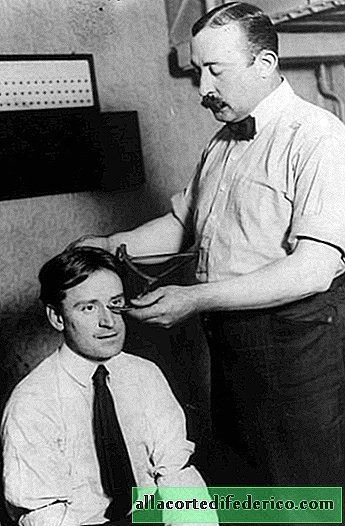Photographic evidence of the past: how they used to fight against the degeneration of mankind
It is widely known that scientists in Nazi Germany fought for the purity of the race and tried to improve the human gene pool. However, the science of human selection arose much earlier, back in the 19th century. And not at all in Germany. The teaching was first born in England, and Francis Galton, a cousin of Charles Darwin, is considered his father. He even coined the term for this doctrine - eugenics, which from ancient Greek translates as "good kind, noble." She studied the ways and possibilities of improving the hereditary properties of man, and also fought against the phenomena of degeneration in the human gene pool.
Galton's ideas were quite romantic: "... eugenics improves the innate properties of the race, bringing to the highest point the development of the best of them.". He wanted to improve human nature, dreamed of breeding a breed of people with outstanding physical and mental data. This was done for the benefit of the whole world.
However, ways to deal with deviations were far from always humane: sterilization, killing of representatives of the "lower race", a ban on the appearance of offspring in people with disabilities and any physical abnormalities. Such people were considered "genetic garbage." And often, such measures were carried out without the consent of "inferior" people, moreover, they did not always know that they were to be sterilized. Supporters of eugenics believed that if they were not allowed to multiply “inferior”, this would save humanity from many diseases: cleft lip, cleft palate, deafness, dwarfism and others. Moreover, scientists thought that eugenics was able to rid society of criminals, as it was believed that the propensity for delinquency was transmitted genetically.
The world's first law on forced sterilization of people with disabilities was passed in Indiana, USA in 1907. Within a few years, the law spread to several states, in some cases even cohabitation and marriage were prohibited, and for violating the law one could go to prison for several years. The law was different in different states, but in general, blind, deaf, epileptic, people with physical deformities, representatives of different races, alcoholics and crazy people fell under it. In Germany, a similar law was adopted only 36 years later, in 1933.
People were selected not only in Nazi Germany, but also in democratic countries, and much earlier. Here is a series of scary photos that show all the horrors of eugenics and the struggle to "purify" society.
The beginning of the twentieth century. A New York police officer conducts anthropometric measurements of a criminal. These measurements were then used by scientists in their studies, trying to calculate the propensity for delinquency. Criminals were considered crazy and offered to sterilize them. Also, such measurements helped identify carriers of "bad genes."


1912 year. Indian dwarfs photographed next to a giant. The members of the Eugenics Society tried to explore the possibilities of regulating human growth.

1902, Paris. Fich Henri Leon, convicted felon with body measurements.

1885, National Academy of Sciences, USA. Scientists measure the volumes of several skulls by pouring water into them and trying to identify the differences.

1885, National Academy of Sciences, USA. The perfect skull.

1925, Kansas, USA. The search for "ideality" was carried out not only among skulls, but also among people. The photo was taken at the competition "Ideal Family", held in the city of Topeka. The Fitter family are finalists of the contest, an example of a genetically ideal family. Such competitions in the United States were very popular, so they tried to encourage people to establish large families.

Well, as for the "imperfect families", inferior, they were sterilized. On the map of 1921, those states are marked where forcibly sterilized mentally and physically disabled citizens. New York is one of them. By 1938, the number of states increased to 33. Often, patients were not even told exactly what procedure they had to do.

1914, France. A poster that depicts the types of skulls of criminals - "genetic garbage."

1932, Schleswig-Holstein, Germany. The head of a young child is measured in order to determine the quality of the genetic material. Some supporters of eugenics adhered to drastic measures and proposed cutting out entire groups of people who had insufficiently correct indicators.

Britain is also not far gone. In 1907, the Society for the Study of Eugenics called for restricting marriage to some categories of citizens, while others forced to sterilize to prevent degeneration of the population. In 1908, Winston Churchill supported the sterilization of the demented, and in 1931 a bill on sterilization was introduced in the country's parliament. In the photo - British phrenologists show how to measure the skull.

1937, London. A phrenologist teaches students how to diagnose a person’s mental inferiority by the shape of a skull.

1931, Washington. In the USA, competitions were held not only for "ideal families", but also for the competition "Best Baby". Doctors select perfect infants up to two years old.

Sometimes more stringent methods were used. In some medical institutions, the mentally ill were intentionally infected with tuberculosis, after which they died. Doctors believed that they were saving humanity from genetic waste.

1938, Tibet. German anthropologist Bruno Berger measures the skull of a local resident to prove that the Tibetans belong to the "lower race". Berger worked at the Anenerbe organization, which studied the origins of the Aryan race. He measured the skulls of lower races to help the Nazis scientifically identify Jews by their skull shape.

A poster that shows the features of the "lower race." As you can see, Neanderthals, Australian Aborigines and Africans are represented here.

1926, Philadelphia. Similar posters were popular throughout the state. The inscription on them reads: "Some people were born just to be a burden to the rest. Every 15 seconds, 100 of your dollars is spent on the maintenance of people with genetic defects - crazy, demented, criminals.". On average, in the 1920s, the salary was $ 117, and for the $ 235 you could buy the brand new Harley-Davidson.

1894, Paris. Forensic scientist Alphonse Bertillon measures the skull of a criminal. He created his system of anthropometry and believed that the shape of the skull can be used to determine in advance the criminal inclinations of a person.

Alphonse Bertillon shows how to measure the ears of criminals.

The study of the types of human noses with the same Alfons Bertillon.

The Bertillon system has become an entire scientific base for eugenics researchers. Based on anthropometric data, they called for the deprivation of the rights of "defective" people. And "defectiveness" was determined by the shape of the skull. In the photo: the class is studying Bertillon’s criminal identification method based on measuring body parts.

Alexandro Maspoli on the cover of the French magazine La Culture Physique. Maspoli was recognized "the ideal representative of the human race".

Dwarf family. The photo was taken as part of a study designed to exclude "bad genes" from society. The authors are outraged that some families after the birth of the first “defective” child do not stop from subsequent childbearing.

1915, Sweden. Lesson on measuring skulls. Sterilization laws have been passed in other European countries: Denmark, Sweden, Norway, Finland.

London, 1912 The poster shows a girl with a cleft lip. A poster encourages people like her not to breed.

USA, exhibition "Eugenics and Health". People came to listen to a lecture that tells how you can deal with people's illiteracy through selection.

Photograph taken for the 1912 lecture. The idea of the lecture - eugenics does not allow such genes in humans.

Eugenics was popular in the first half of the twentieth century, but later it began to be associated with Nazism, since not all methods were humane, so the reputation of the doctrine suffered greatly. Eugenics was banned, as well as other crimes against humanity committed by the Nazis: racial hygiene, experiments on people, the destruction of the "lower race". But at the end of the twentieth century, the development of reproductive technologies and genetics again brings us back to eugenics, to its significance and ethical status in the modern world.

















